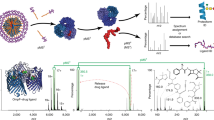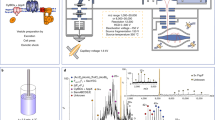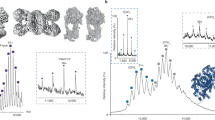Abstract
Small molecules are known to stabilize membrane proteins and to modulate their function and oligomeric state, but such interactions are often hard to precisely define. Here we develop and apply a high-resolution, Orbitrap mass spectrometry–based method for analyzing intact membrane protein–ligand complexes. Using this platform, we resolve the complexity of multiple binding events, quantify small molecule binding and reveal selectivity for endogenous lipids that differ only in acyl chain length.
This is a preview of subscription content, access via your institution
Access options
Subscribe to this journal
Receive 12 print issues and online access
$259.00 per year
only $21.58 per issue
Buy this article
- Purchase on Springer Link
- Instant access to full article PDF
Prices may be subject to local taxes which are calculated during checkout



Similar content being viewed by others
References
Almén, M.S., Nordström, K.J.V., Fredriksson, R. & Schiöth, H.B. BMC Biol. 7, 50 (2009).
Marcoux, J. & Robinson, C.V. Structure 21, 1541–1550 (2013).
Laganowsky, A. et al. Nature 510, 172–175 (2014).
Marcoux, J. et al. Proc. Natl. Acad. Sci. USA 110, 9704–9709 (2013).
Whitelegge, J.P. Photosynth. Res. 78, 265–277 (2003).
Brügger, B. Annu. Rev. Biochem. 83, 79–98 (2014).
Lee, A.G. Mol. Biosyst. 1, 203–212 (2005).
Zubarev, R.A. & Makarov, A. Anal. Chem. 85, 5288–5296 (2013).
Rose, R.J., Damoc, E., Denisov, E., Makarov, A. & Heck, A.J.R. Nat. Methods 9, 1084–1086 (2012).
Dyachenko, A. et al. Anal. Chem. 87, 6095–6102 (2015).
Barrera, N.P., Di Bartolo, N., Booth, P.J. & Robinson, C.V. Science 321, 243–246 (2008).
Reading, E. et al. Angew. Chem. Int. Ed. Engl. 54, 4577–4581 (2015).
Hopper, J.T.S. et al. Nat. Methods 10, 1206–1208 (2013).
Laganowsky, A., Reading, E., Hopper, J.T.S. & Robinson, C.V. Nat. Protoc. 8, 639–651 (2013).
Hopper, J.T.S. & Robinson, C.V. Angew. Chem. Int. Ed. Engl. 53, 14002–14015 (2014).
Marty, M.T. et al. Anal. Chem. 87, 4370–4376 (2015).
Bechara, C. et al. Nat. Chem. 7, 255–262 (2015).
Zhou, M. et al. Science 334, 380–385 (2011).
Raetz, C.R. Microbiol. Rev. 42, 614–659 (1978).
Garrett, T.A., O'Neill, A.C. & Hopson, M.L. Rapid Commun. Mass. Spectrom. 26, 2267–2274 (2012).
Michalski, A. et al. Mol. Cell. Proteomics 10, (9):M111.011015 (2011).
Snijder, J. et al. J. Am. Chem. Soc. 136, 7295–7299 (2014).
Barrera, N.P. et al. Nat. Methods 6, 585–587 (2009).
Tito, M.A., Tars, K., Valegard, K., Hajdu, J. & Robinson, C.V. J. Am. Chem. Soc. 122, 3550–3551 (2000).
McKay, A.R., Ruotolo, B.T., Ilag, L.L. & Robinson, C.V. J. Am. Chem. Soc. 128, 11433–11442 (2006).
Tan, Q. et al. Science 341, 1387–1390 (2013).
Aller, S.G. et al. Science 323, 1718–1722 (2009).
Xu, Y. et al. Nature 515, 448–452 (2014).
Housden, N.G. et al. Proc. Natl. Acad. Sci. USA 107, 21412–21417 (2010).
Housden, N.G. et al. Science 340, 1570–1574 (2013).
Bligh, E.G. & Dyer, W.J. Can. J. Biochem. Physiol. 37, 911–917 (1959).
Bird, S.S., Marur, V.R., Sniatynski, M.J., Greenberg, H.K. & Kristal, B.S. Anal. Chem. 83, 940–949 (2011).
Acknowledgements
The authors would like to thank L. Feng and W. Frommer (Stanford School of Medicine) for the semiSWEET plasmid. This work has benefited from the expertise of the Protein & Nucleic Acid Chemistry Facility, Department of Biochemistry, University of Cambridge, UK for quantification of the OBS1 peptide. We would also like to thank A. Baldwin for help with dissociation constant calculations. K.G. is supported by a Royal Commission for the Exhibition of 1851 Fellowship and a Junior Research Fellowship at St Catherine's College, Oxford. J.A.C.D. is supported by an Engineering and Physical Sciences Research Council studentship held at the Life Sciences Interface Doctoral Training Centre. M.T.M. and J.T.S.H. are funded by program grant G1000819 (C.V.R.) from the UK Medical Research Council. J.G. is funded by a European Research Council Investigator Award (IMPRESSS, grant no. 268851) (C.V.R.). C.V.R. is supported by a Royal Society Research Professorship and a Wellcome Trust Senior Investigator Award (grant no. 104633/Z/14/Z). C.V.R. and C.K. acknowledge BBSRC for funding (BB/L021234/1) (C.K.).
Author information
Authors and Affiliations
Contributions
J.G. and C.V.R., with assistance from J.T.S.H., designed the research. M.B., E.D., A.M., T.M. and J.G. modified the Q Exactive mass spectrometer and optimized the MS experiment for membrane protein complexes. J.G., J.A.C.D., I.L., K.G., J.T.S.H. and W.B.S. expressed and purified membrane proteins in appropriate conditions for nondenaturing MS. J.G., J.A.C.D. and I.L. performed MS experiments. J.G. and J.A.C.D. performed lipidomics experiments and data analysis. Y.Z. and B.W. provided a sample of the CCR5 protein. N.G.H. and C.K. provided samples of the OmpF protein and OBS1 peptide. C.B. set up the lipidomics platform. M.T.M. modified the UniDec software for use in this work. J.G. and C.V.R. wrote the manuscript with contributions from all other authors.
Corresponding author
Ethics declarations
Competing interests
E.D., M.B. and A.M. are employees of Thermo Fisher Scientific, the manufacturer of the Q Exactive instrument used in this research.
Integrated supplementary information
Supplementary Figure 1 Schematic of modified Q Exactive instrument with major modifications indicated.
Further details are provided in the Online Methods section.
Supplementary Figure 2 Gradual release of the AmtB trimer from C8E4 micelle upon increasing collision energy in the HCD cell.
The protein is completely released by accelerating ions into the HCD cell with 100 V and detergent continues to be stripped without charge state broadening up to 200 V.
Supplementary Figure 3 Spectra of pentameric ligand-gated ion channel ELIC acquired at different HCD pressures.
Pressures as measured with UHV pressure gauge (mbar). Due to the location of the gauge to calculate actual pressure in the HCD cell a scaling factor must be applied to the values from the read back stated here. (a) 6×10-10, (b) 9.09×10-10, (c) 1.35×10-9, (d) 1.76×10-9, (e) 2.43×10-9. At low pressure (a) only monomeric ELIC is transmitted. This probably because the collisional cooling effect in the HCD cell is insufficient to retain the more massive, higher order oligomers. As the pressure is increased b-c) the transmission of higher mass species is improved and the familiar ELIC spectrum of pentamer accompanied by stripped tetramer and monomer is observed. At higher pressures d-e) dissociation appears to be reduced until only the intact pentamer is observed.
Supplementary Figure 4 Representative data set for titration of OBS1 peptide with OmpF trimer at different concentrations of peptide ligand.
Concentration of OmpF trimer in each case is 8.9 μM.
Supplementary Figure 5 Overall binding of OBS1 peptide to OmpF
(a) Overall binding of OBS1 peptide to OmpF and fit to a single site binding model as described previously30 giving best fit KD of 0.69 mM (0.64 ± 0.14 mM after 1,000 bootstraps). (b) Individual microscopic site KD’s for successive binding events. Microscopic KDs for a 1 protein, 3 ligand, 3 binding sites per protein model were obtained by testing different fit models (free, single KD) choosing the best model based on an F-test. This was consistently the free model which allows each binding event to have a different KD. All data was processed using the data collector module of the UniDec software which is available for download at http://unidec.chem.ox.ac.uk 16. (c) Distribution of errors for calculation of microscopic KDs after 1000 bootstraps.
Supplementary Figure 6 P-gp bound to lipids and drugs
(a) Mass spectrum of P-gp. The increased resolution now reveals three major proteoforms labelled P1, P2 and P3 in contrast to previous results4. (b) Binding of cardiolipin 14:0 (CDL 14:0, blue square) to P-gp Binding is observed on all three preforms. (c) Binding of drug Cyclosporin A (CsA, red circle) to P-gp. Binding is again observed on all three preforms. (d) Concomitant binding of both drug and lipid. Insets are zooms of single charge states showing up to two binding events.
Supplementary Figure 7 Binding of individual lipids of different chain lengths and degrees of unsaturation to OmpF trimer
(a) DMPG, (b) DPPG, (c) POPG. The mass spectrum of OmpF trimer binding to POPG allows a good estimation of the dynamic range of such measurements with clear peaks discernible over 1.5 to nearly 2 orders of magnitude.
Supplementary Figure 8 Identification of CDL in total lipid extract.
(a) MS Full scan TIC of total lipid extract analyzed by RP LC-MS. (b) Summed MS scans corresponding to the region where cardiolipin elutes showing the distribution of CDL with different chain lengths. (c) MS/MS spectrum of the peak at 1375.97 m/z identifying the lipid as 66:2 CDL by similarity to reported CDL spectra (Hsu, F.-F. et al., Journal of the American Society for MS 16, 491-504 (2005).)
Supplementary information
Supplementary Text and Figures
Supplementary Figures 1–8 and Supplementary Tables 1 and 2 (PDF 1318 kb)
Rights and permissions
About this article
Cite this article
Gault, J., Donlan, J., Liko, I. et al. High-resolution mass spectrometry of small molecules bound to membrane proteins. Nat Methods 13, 333–336 (2016). https://doi.org/10.1038/nmeth.3771
Received:
Accepted:
Published:
Issue Date:
DOI: https://doi.org/10.1038/nmeth.3771
This article is cited by
-
Structural basis for lipid and copper regulation of the ABC transporter MsbA
Nature Communications (2022)
-
Capturing a rhodopsin receptor signalling cascade across a native membrane
Nature (2022)
-
Peptidoglycan biosynthesis is driven by lipid transfer along enzyme-substrate affinity gradients
Nature Communications (2022)
-
Mass spectrometry captures biased signalling and allosteric modulation of a G-protein-coupled receptor
Nature Chemistry (2022)
-
The GFP thermal shift assay for screening ligand and lipid interactions to solute carrier transporters
Nature Protocols (2021)



